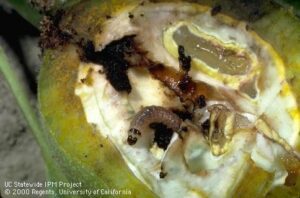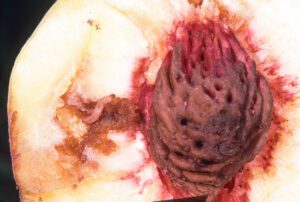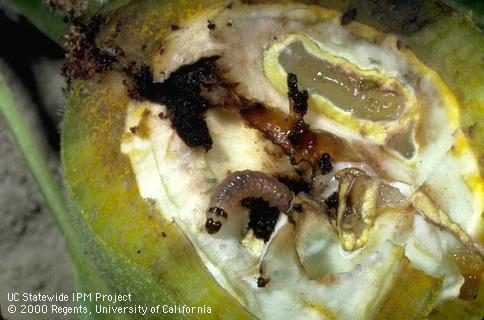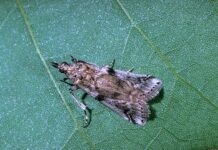Scientists are keeping a close eye on the way a warmer planet will affect pests and California agriculture. Since insect pests are highly dependent on external outside temperatures, tree and nut pests like navel orangeworm (NOW), codling moth, peach twig borer and oriental fruit moth will likely emerge sooner and produce more generations in the coming years.
A recent study published in the journal Science of the Total Environment specifically examined codling moth, peach twig borer and oriental fruit moth, which damage walnuts, almonds and peaches. The study was conducted with scientists at UC Merced, USDA, UC ANR and the California Climate Hub at UC Davis, and is the second study of this type focusing on pests and climate change. It reports that, despite California being the leader or top producer of these specialty crops, productions of these crops are highly vulnerable to climate change due to high chill requirements and low tolerance to heat.

The researchers first conducted a study on NOW that looked at how the climate affected the population, when it begins to start activity in the springtime, how long it takes to complete generations, and whether temperature increases had any impact on each of those. Results from that study concluded that NOW will likely see a fifth generation in the southern portion of the valley as soon as 2040.
The second study, led by UC ANR assistant project scientist Prakash Jha, examined the three other pests in a similar way, according to study co-author Jhalendra Rijal, IPM advisor and entomologist for Stanislaus, San Joaquin and Merced counties.
“We found there are definitely some impacts on the population of these pests, there’s more generations that we need to think about for future effective pest management,” Rijal said.
He noted it has only been in the last few years that a full fourth generation of NOW has occurred, and the impact has been especially noticeable this year as some nut crops were harvested late, especially almonds.

As troubling as the issue might sound, Rijal said the impact of climate change is a slow process, and the purpose of the study wasn’t to create panic, rather to see how these changes happen, to what extent they will happen in the future, and how they can be mitigated.
“In that case we will be more prepared in terms of doing research for the industry, creating awareness to the growers and pest control advisors, and educating the entire community about what’s happening and what can be done in the future,” he said.
Ideal Conditions for Pests to Thrive
Insect pests, which are cold blooded and cannot regulate their own body temperature, rely on the ambient temperature to control vital functions like feeding and reproduction, Rijal explained.
That’s why warmer conditions that lead to higher heat unit accumulations per calendar day can have room for more generations within the same period.
“If you think about that for the whole year perspective, that’s how there’s likelihood that an extra generation can happen,” Rijal said. “And in the case of codling moth, peach twig borer and oriental fruit moth, based on this latest study, we see that we will likely see about 1.5 generations increase by the end of the century.”
He added that while the end of the century seems far away, in terms of planning for future production and what result an increase in pest generations will have on those crops, it’s important to look several decades ahead on a tree’s entire life span.
“If you think of it in that perspective, it’s not a long time,” Rijal said. “That’s the educational part we wanted to bring with this.”
Giving Growers the Tools to Adapt
Another important goal of the study, according to Rijal, was to help growers and PCAs improve their IPM practices based on what the future might look like with pests and climate change. He said the study could also give scientists a push to do more applied work in the future as they develop and improve prediction models such as degree day models, which they use routinely to manage and monitor insects on a day-to-day basis. He said it could also be used to inform the industry and commodity boards about what kind of research and educational support they should provide in the future.
One tool the researchers hope will help mitigate the issue is a website they created called CalAgroClimate.org, which publishes several different models, including heat and frost advisory models and pest phenology models. PCAs can visit the site to input temperature data or search temperature data and pest predictions of a specific location.
Dr. Tapan Pathak, a CE specialist in climate adaptation in agriculture at UC Merced, was one of the study’s co-authors and a corresponding author. He said the important thing to look at with climate change and what it means for agriculture has to do a lot with the rate of increase in the minimum temperatures, which has increased significantly higher than the rate of maximum temperatures.
The difference between the daily minimum and maximum temperatures, called diurnal temperature, is shrinking, he explained, and that’s significant.
“That means when it comes to agriculture, there are many consequences related to temperature increases,” Pathak said, noting those impacts could include negative outcomes on things like heat units and fruit quality.
It also has a bearing on pests because their life cycles start much earlier in the season.
“It used to be maybe mid-March, but because of those minimum temperatures, their cycle could start as early as mid- or late February,” Pathak said. “So, they have a longer timeframe during the growing season.”
Pathak worked on a climate model analysis for the study that focused on California climate. He said they chose a few select models relevant to the state called general circulation models, or GCM.
“What they bring is expected future reality,” he said.
He said the models are a reliable gauge to how temperatures might change in the future and what that means for farmers.
“What we are trying to do, rather than just providing raw changes in temperatures, is to assess impacts on different aspects of agriculture and say how changes in temperature are going to result in changes in pest behavior that’s directly going to affect your crops,” Pathak said.
He noted the study is meant to show two important things: To provide a reality check for the agricultural community to see what future risk might look like, and to help them better prepare for a world with more pests to contend with.
Going forward, Pathak said they will work with farmers to provide pest management guidelines and continue to drive home the importance of IPM.
“These pests might be creating less issues now, but if you don’t pay attention, there could be more risk in the future,” he said.
In addition to Jha, Rijal and Pathak, the study was also co-authored by Ning Zhang, Lauren E. Parker and Steven Ostoja of the UC Davis Institute of the Environment. The most recent study titled “Climate change impacts on insect pests for high value specialty crops in California” and the previous study titled “Impact of climate change on navel orangeworm, a major pest of tree nuts in California” can be found on www.sciencedirect.com.












